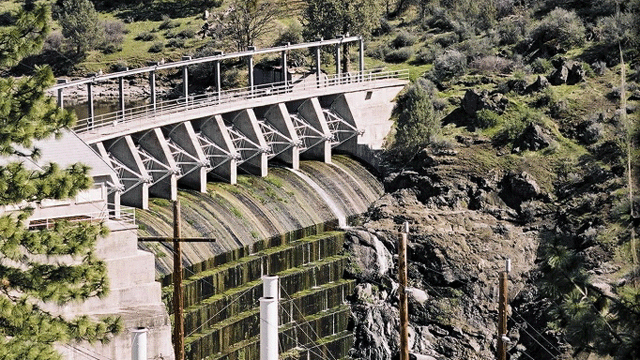
The Interior Department has released a new study that shows removing four hydroelectric dams would provide an economic boon to farmers without damaging the environment. (AP)
The Klamath River in California and Oregon has long been central to a century-old dispute between environmentalists and farmers over which has more value -- spawning salmon or drought-ridden farmers.
Now the Interior Department has released a new study of the river as part of a landmark settlement in 2010 that shows removing four hydroelectric dams – three in Northern California and the fourth in Southern Oregon -- would provide an economic boom to farmers without damaging the environment.
The draft environmental impact statement, released Wednesday, says that the proposed dam removal in 2020 would help boost salmon runs in a river marked by poor water quality and fish disease.
Although removing the dams would cost about 50 jobs tied to generating electricity at the dams, it would also create about 4,600 jobs, including about 1,400 for the dam removal itself and between 70 and 695 farm jobs owing to a more reliable water supply, Interior Secretary Ken Salazar said.
Salazar is expected to decide next year whether to go ahead with the dam removal under a regional agreement that would maintain irrigation for agriculture.
But the statement has garnered mixed reviews.
“This one statement is really just one piece of the puzzle,” said Tara Jane Campbell Miranda, the policy and program coordinator with the Klamath Water Users Association, which represents more than 5,000 water users on 1,400 family farms.
“Our initial review is this is a good thing. We’re moving in the right direction,” she said, adding that the statement would help implement the actions called for in the legal settlement.
But Steve Pedery, conservation director of Oregon Wild, which boasts 4,000 members, told FoxNews.com that the statement is “sort of a continuation of the same old same old” and contains “a lot more fluff than substance.”
“In the long run, the report is helpful in the debate over dam removal,” he said. “But it doesn’t change the fundamental problem in the basin.”
The problem began in the early 1900s, when the federal government turned the hydrology of the upper Klamath Basin upside down, drawing water from lakes and rivers to irrigate crops on dry uplands. Veterans of World War I homesteaded the Klamath Reclamation Project straddling the Oregon-California border near Klamath Falls, where potatoes, alfalfa, horseradish and cattle are still grown.
A drought in 2001 brought the conflict to a head.
Irrigation for farms had long been constricted to assure enough for endangered sucker fish in Upper Klamath Lake, the project’s main reservoir. Then coho salmon were declared threatened in the Klamath River, flowing out of the lake, and the Endangered Species Act forced water to be shut off to hundreds of farms and ranches.
The next year, the Bush administration restored water to the farms, but with the river low and warm, tens of thousands of chinook salmon died of disease before they could spawn.
Besides blocking salmon, the dams raise water temperatures to levels unhealthy for fish. California water authorities took a hard look at the toxic algae produced by the dam’s reservoirs, and river advocates sued PacifiCorp to fix the algae problem.
Last year, two landmark agreements were signed – one that laid out a roadmap for removing the four dams from the Klamath River in Southern Oregon and Northern California and the other detailing how to share water between fish and farms and restore the ecological balance of the basin. Water will be shut off to farms in extreme drought.
The Interior Department said Wednesday that drawing down the reservoirs would end conditions that create toxic algal blooms. It said millions of cubic yards of sediment would be flushed out, and fish numbers might suffer briefly but would soon rebound and then increase.
Both sides, though are pessimistic about the full agreement being implemented because it calls for spending $1 billion in federal funds over the next 10 years on environmental restoration at a time when Congress is battling over how much to cut from the deficit and debt.
Congress is in no mood for new spending, said Pedery of Oregon Wild.
“Unless you take steps so we have cleaner water, you’re really not going to solve the problem,” he said.
Greg Addington, executive director of the Klamath Water Users Association, said while the Bush administration negotiated about 99 percent of the settlement, the Obama administration approves of it.
“But now you’ve got Congress – Republicans in the House, Democrats in the Senate – and no money,” he said. “So we’ve got our work cut out for us.”
The Associated Press contributed to this report.




